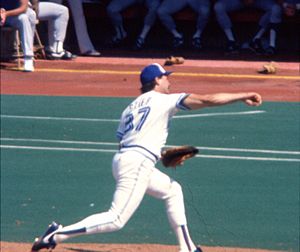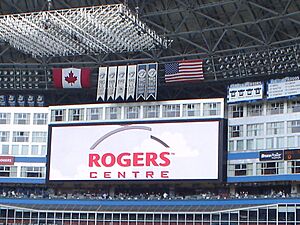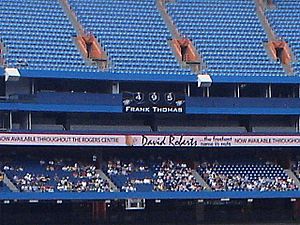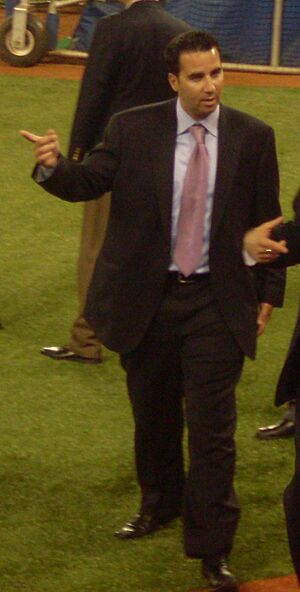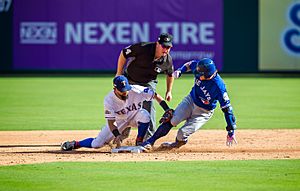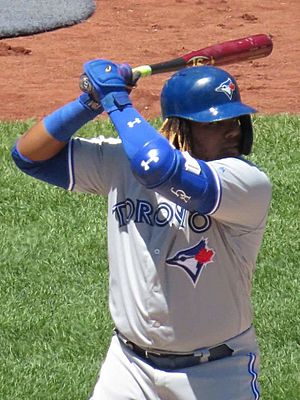History of the Toronto Blue Jays facts for kids
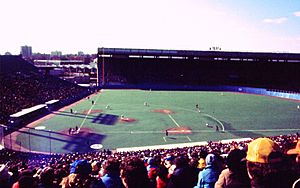
The Toronto Blue Jays baseball team started in 1976. They were one of two new teams joining the American League in 1977. Before this, Toronto had a long history with baseball. The city was home to the Toronto Maple Leafs baseball team from 1896 to 1967. Since 1989, the Blue Jays have played their home games at Rogers Centre, which used to be called SkyDome.
Contents
How the Blue Jays Started
Almost the Toronto Giants
In January 1976, the owner of the San Francisco Giants baseball team wanted to sell his team. A group from Toronto, led by Don McDougall, agreed to buy the team. This group included Labatt Breweries, Vulcan Assets, and the Canadian Imperial Bank of Commerce (CIBC).
The plan was for the team to play at Exhibition Stadium in Toronto starting in 1976. The stadium was even updated for baseball. The team would have been called the Toronto Giants. However, a U.S. court stopped the move. After this, Bob Lurie bought the Giants and kept them in San Francisco.
Joining the American League
Even though the Giants didn't move, Toronto still wanted a Major League Baseball (MLB) team. MLB decided to add new teams in 1976. This was partly to fix a problem with Seattle, Washington. Their team, the Seattle Pilots, had moved away after only one season in 1970.
To make the league have an even number of teams, two new teams were added. One went to Seattle, and the other went to Toronto. The same group from Toronto (Labatt Breweries, Webster, and CIBC) bought the rights to the team for $7 million.
There was a brief moment when it seemed Toronto might not get the team. The U.S. President at the time, Gerald Ford, wanted Washington, D.C., to get a team instead. Washington had not had a major league team since 1972. However, President Ford's efforts didn't change anything. Toronto was allowed to keep its American League team.
The Blue Jays and the Seattle Mariners were officially approved as new teams in 1977. Paul Beeston was the first employee hired in 1976. He later became president of the Blue Jays. Before the team's first season in 1977, Peter Bavasi became president and general manager. Pat Gillick was named assistant general manager.
Choosing the Team Name
The name "Blue Jays" was chosen in 1976. The team held a "name the team" contest, and over 4,000 ideas were sent in. 154 people suggested "Blue Jays." Dr. William Mills was chosen as the winner.
Dr. Mills said that blue is a traditional color for Toronto sports teams. He also liked that the name was a bird, like the Baltimore Orioles or St. Louis Cardinals. The team likely would have used blue colors anyway. Blue has been the main color for many Toronto teams since the Toronto Argonauts started using it in 1873.
1977–1994: The Pat Gillick Years
Early Years: 1977–1981
The Blue Jays played their very first game on April 7, 1977. They played against the Chicago White Sox in front of 44,649 fans. A small snowstorm started just before the game. Toronto won the snowy game 9–5, with Doug Ault hitting two home runs. This was one of only 54 wins that season. The Blue Jays finished last in their division with a record of 54–107. After this season, Pat Gillick became the team's general manager. He held this job until 1994.
In 1978, the team won 59 games, but still finished last. In 1979, after another last-place finish, shortstop Alfredo Griffin was named American League co-Rookie of the Year. The Blue Jays also introduced their first mascot, BJ Birdy, in 1979.
In 1980, Bobby Mattick became the new manager. He wanted the team to lose fewer than 100 games. The Jays almost reached 70 wins, finishing with a record of 67–95. This was a big improvement. Jim Clancy led the team with 13 wins. John Mayberry was the first Blue Jay to hit 30 home runs in a season.
In the 1981 season, which was shortened by a strike, the Jays finished last again. They had a combined record of 37–69. After the season, Mattick stepped down as manager.
Building Up: 1982–1984
With new manager Bobby Cox, Toronto kept getting better in 1982. They finished 78–84, tying for sixth place in their division. This was the first time they weren't the worst team in the division. Their pitchers included Dave Stieb, Jim Clancy, and Luis Leal. Young outfielders Lloyd Moseby and Jesse Barfield were also key players. First baseman Willie Upshaw was the first Blue Jay to have at least 100 RBIs in a season.
In 1983, the Jays had a big breakthrough. They had their first winning record, 89–73. They finished in fourth place, nine games behind the Baltimore Orioles. This was the start of 11 winning seasons in a row for the team.
The Blue Jays continued to improve in 1984. They finished with the same 89–73 record. After the 1984 season, Alfredo Griffin was traded. This gave a permanent spot to young shortstop Tony Fernández, who became a fan favorite.
1985: First Division Title
In 1985, Toronto won its first championship: the American League East division title. The Blue Jays had strong pitching and a balanced offense. Relief pitcher Tom Henke also joined the team and became very important. They finished with a franchise record of 99 wins and 62 losses.
The Blue Jays then played the Kansas City Royals in the American League Championship Series (ALCS). Toronto took a 3-1 lead in the series. However, Kansas City won the next three games to win the series 4-3. They then went on to win the World Series. After this loss, Bobby Cox left the Blue Jays.
Ups and Downs: 1986–1988
With Jimy Williams as the new manager, the Blue Jays didn't do as well in 1986. They finished in fourth place with 86 wins and 76 losses. Jesse Barfield hit 40 home runs, and George Bell hit 31.
In 1987, the Blue Jays almost won their division again. They lost to the Detroit Tigers by just two games after losing their last seven games of the season. The Blue Jays finished with 96 wins and 66 losses, the second-best record in MLB. George Bell was named the Most Valuable Player (MVP) of the American League. He was the first Blue Jay to win this award.
In 1988, Toronto finished third in their division with 87 wins and 75 losses. First baseman Fred McGriff hit 34 home runs. Pitcher Dave Stieb almost pitched two no-hitters, losing them in the ninth inning.
New Home, New Success: 1989–1991
In 1989, the Blue Jays' new stadium, SkyDome, opened in June. This started a very successful five-year period for the team. In May, the team fired manager Jimy Williams. They replaced him with Cito Gaston, who was the team's hitting coach. The team had a record of 12 wins and 24 losses when Gaston took over. But under him, they won 77 games and lost 49. This helped them win the American League East title by two games.
The Blue Jays played their last game at Exhibition Stadium on May 28, 1989. They won 7–5 against the Chicago White Sox. The first game at SkyDome was on June 5 against the Milwaukee Brewers. The Jays lost that game 5–3. In the 1989 American League Championship Series, the Oakland Athletics beat the Blue Jays 4 games to 1.
In 1990, the Blue Jays finished second, two games behind the Boston Red Sox. Dave Stieb pitched the only no-hitter in Blue Jays history, beating the Cleveland Indians 3–0. During the off-season, the Blue Jays made a huge trade. They sent all-star shortstop Tony Fernández and first baseman Fred McGriff to the San Diego Padres. In return, they got outfielder Joe Carter and second baseman Roberto Alomar. They also got center fielder Devon White. These trades were very important for the team's future success.
Carter, Alomar, and White were great additions. The Blue Jays won their division again in 1991. However, they lost in the postseason to the Minnesota Twins in the ALCS. In 1991, the Blue Jays became the first MLB team to have over four million fans attend their games in one season.
- Team record 1989: 89 wins–73 losses (54.9% winning)
- Team record 1990: 86 wins–76 losses (53.1% winning), 2 games behind division leader
- Team record 1991: 91 wins–71 losses (56.2% winning)
World Series Champions: 1992–1993
First World Series Title: 1992
After the 1991 season, the Blue Jays got pitcher Jack Morris. He had just led the Minnesota Twins to a World Series win. They also signed future Hall of Famer Dave Winfield to add experienced leadership.
The 1992 season went very well. The Jays won their second straight AL East title with a record of 96 wins and 66 losses. They were four games ahead of the Milwaukee Brewers. The Blue Jays also went the whole season without being swept in any series.
The Blue Jays played the Oakland Athletics in the ALCS. Toronto won 4 games to 2. A key game was Game 4. The Blue Jays came back from being down 6–1. Roberto Alomar hit a huge game-tying home run in the ninth inning. This led to a 7–6 win in 11 innings.
The Blue Jays then faced the Atlanta Braves in the World Series. Game 2 was very important. Reserve player Ed Sprague hit a 9th-inning home run to give the Blue Jays a 5–4 lead, which they held onto. After winning Game 3 and Game 4, the Jays had a 3-1 lead. They couldn't win the Series at home in Game 5. Game 6 in Atlanta was very close. Toronto was one strike away from winning 2–1 in the 9th inning. But the Braves tied the game. In the 11th inning, Dave Winfield hit a double that drove in two runs. The Blue Jays won the game and the series.
The Blue Jays became the first team outside of the United States to win the World Series. Pat Borders, the Jays' catcher, was named the World Series MVP. Morris, who was known for his playoff pitching, went 0–3 in the playoffs. However, he had a great regular season, becoming the Blue Jays' first 20-game winner.
- Team record 1992: 96 wins–66 losses (59.3% winning)
Back-to-Back Champions: 1993
After the 1992 season, the Blue Jays signed two important players. They got designated hitter Paul Molitor and pitcher Dave Stewart.
In 1993, the Blue Jays had seven All-Stars. These included outfielders Devon White and Joe Carter, infielders John Olerud and Roberto Alomar, Paul Molitor, pitcher Pat Hentgen, and closer Duane Ward. In August, the Jays got Rickey Henderson. The Blue Jays easily won their division with 95 wins and 67 losses. This was their third straight division title.
The Jays beat the Chicago White Sox 4 games to 2 in the ALCS. Then they beat the Philadelphia Phillies 4 games to 2 to win their second straight World Series. The World Series had many exciting games. Game 4 was played in light rain. The Blue Jays came back from being down 14–9 to win 15–14. This is still the highest-scoring game in World Series history.
In Game 6 in Toronto, the Blue Jays were leading 5–1. But the Phillies scored 5 runs in the 7th inning to take a 6–5 lead. In the bottom of the 9th inning, Joe Carter hit a three-run home run to win the series! This is the only time in MLB history a team has won the World Series with a walk-off home run while trailing in the 9th inning.
In the regular season, three Blue Jays players were the top three in batting average in the American League. These were John Olerud, Paul Molitor, and Roberto Alomar.
- Team record 1993: 95 wins – 67 losses (58.6% winning)
1994 Season
People had high hopes for the Blue Jays in 1994 after their two championships. But the team struggled. They had a record of 55 wins and 60 losses. They finished third in their division when the players' strike began in August. This strike canceled the rest of the season. It was their first losing season since 1982.
Joe Carter, Paul Molitor, and John Olerud had good hitting years. But the pitching was not as strong. Young players like Alex Gonzalez, Carlos Delgado, and Shawn Green showed a lot of promise for the future.
- Team record 1994: 55 wins–60 losses (47.8% winning), 16 games behind division leader
1995–2001: The Gord Ash Years
Before the 1995 season, Pat Gillick, the long-time general manager, left. Gord Ash took over.
In 1995, the Blue Jays did not play well. They had many of the same players from their World Series teams. But they finished last in their division with a record of 56 wins and 88 losses. Attendance at games also dropped a lot and took several years to recover.
In 1995, Labatt Breweries was bought by a company from Belgium. This made the Blue Jays the second baseball team owned by a company outside North America.
1996 was another average year for the Blue Jays. However, Pat Hentgen won the Cy Young Award for being the best pitcher. The team won 74 games, finishing in 4th place.
The Blue Jays had high hopes for 1997. They changed their uniforms and signed star pitcher Roger Clemens. Clemens had an amazing season, leading the American League in wins, ERA, and strikeouts. But this was not enough for the Blue Jays to reach the playoffs. They finished last again with 76 wins and 86 losses. Cito Gaston, the manager who led them to two World Series wins, was fired near the end of the season.
Before the 1998 season, the Blue Jays got closer Randy Myers and slugger Jose Canseco. Former Blue Jay Tim Johnson became the new manager. Even with average hitting, strong pitching from Clemens helped the Blue Jays. Clemens won his second straight pitching Triple Crown. The team finished with 88 wins and 74 losses. This was their first winning season since 1993. They finished third in their division.
Before the 1999 season, the Blue Jays traded Clemens to the Yankees. They got pitcher David Wells, second baseman Homer Bush, and relief pitcher Graeme Lloyd. They also fired manager Tim Johnson during spring training. Jim Fregosi became the new manager. The hitting improved in 1999, but the pitching was not as good without Clemens. The Blue Jays finished with 84 wins and 78 losses, in third place. After 1999, the team's mascot, BJ Birdy, was replaced by Ace & Diamond.
In November 1999, Toronto traded star outfielder Shawn Green to the Los Angeles Dodgers. Green wanted to play closer to his home.
The 2000 season was similar. The Jays had 83 wins and 79 losses. They were not far behind the Yankees in their division. Carlos Delgado had a fantastic year, hitting .344 with 41 home runs. Six other players hit 20 or more home runs, which was amazing.
On September 1, 2000, Rogers Communications bought 80% of the team. Rogers later bought the remaining 20% in 2004 and now owns 100% of the team.
Buck Martinez, a former catcher, became the manager before the 2001 season. The Blue Jays finished with 80 wins and 82 losses in 2001. Delgado again led the team with 39 home runs. After the 2001 season, Gord Ash was fired as general manager.
The Blue Jays faced financial challenges because the Canadian dollar was worth much less than the U.S. dollar. This meant they lost money paying players in U.S. dollars. J. P. Ricciardi became the new General Manager. He was expected to lower the team's payroll. The team traded many popular players to give talented young players a chance.
2002–2009: The J. P. Ricciardi Years
2002 Season
The Blue Jays started the 2002 season slowly. Manager Buck Martinez was fired and replaced by Carlos Tosca. The team finished the season with 78 wins and 84 losses. Roy Halladay became the team's top pitcher, with 19 wins and a 2.93 ERA. Carlos Delgado led the hitters. Young players like Eric Hinske and Vernon Wells also played key roles. Hinske won the Rookie of the Year Award.
- Team record 2002: 78 wins–84 losses (48.1% winning), third in division
2003 Season
The 2003 season was a surprise. After a slow April, the team had its best month ever in May. Carlos Delgado led all of MLB in RBIs. But poor pitching continued to be a problem, except for Halladay. Halladay won his first Cy Young Award, with 22 wins and a 3.25 ERA. The Jays finished third in their division. Delgado was second in voting for the American League MVP Award.
- Team record 2003: 86 wins–76 losses (53.1% winning), third in division
2004 Season
The 2004 season was disappointing from the start. The team lost their first eight home games. Many All-Stars like Carlos Delgado, Vernon Wells, and Roy Halladay were injured. Manager Carlos Tosca was fired in August and replaced by John Gibbons. Long-time first baseman Carlos Delgado became a free agent after the season. Young players like Russ Adams, Gabe Gross, and Alex Ríos showed promise for the future.
- Team record 2004: 67 wins–94 losses (41.6% winning), fifth in division
2005 Season
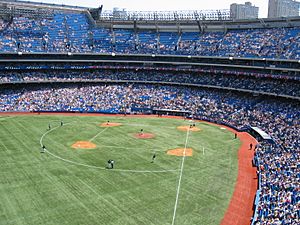
The Blue Jays started the 2005 season well. They were leading their division in April. But injuries hit the team. Ace pitcher Roy Halladay broke his leg in July and was out for the rest of the season. Before his injury, the Blue Jays were competing for a playoff spot. But they fell out of the race after he got hurt.
- Team record 2005: 80 wins–82 losses (49.4% winning), third in division
2006 Season
In 2006, the team had its most successful season in years. Five Blue Jays players were chosen for the All-Star Game. This was the most since 1993. The team played well in September, winning 18 games. This helped them finish in second place in their division. This was the first time they finished higher than third place since 1993. In December, the Blue Jays re-signed center fielder Vernon Wells to a big contract.
- Team record 2006: 87 wins–75 losses (53.7% winning), second in division
2007 Season
The 2007 season was full of injuries. Twelve Blue Jays players ended up on the disabled list. Pitcher B. J. Ryan was out for the whole season after surgery. Young pitchers Shaun Marcum and Dustin McGowan had great years. On June 28, Frank Thomas hit his 500th career home run. Aaron Hill also had a great year, setting a team record for second basemen with 47 doubles.
- Team record 2007: 83 wins – 79 losses (51.2% winning), third in division
2008 Season
The Blue Jays' 2008 season had a very strong pitching staff. They led all of MLB with a 3.49 ERA. But the team struggled to hit home runs and score runs. In June, manager John Gibbons was fired and Cito Gaston was re-hired. Alex Ríos stole 32 bases, the most by a Blue Jay since 2001. On September 5, Roy Halladay got his 129th career win, moving him to second on Toronto's all-time wins list. Halladay also finished second in voting for the Cy Young Award. The team had a 10-game winning streak in late August and early September.
- Team record 2008: 86 wins–76 losses (53.1% winning), fourth in division
2009 Season
In 2009, the Blue Jays wore two new patches on their uniforms. One was a red maple leaf from the Canadian flag. The other was a small black band with "TED" on it, for team owner Ted Rogers, who had passed away.
On opening day, the Jays, led by Roy Halladay, beat the Detroit Tigers. Aaron Hill and Roy Halladay had excellent years and were All-Stars. In mid-August, Alex Ríos was claimed off waivers by the Chicago White Sox. The Jays started the season well but then had a 9-game losing streak. General Manager J. P. Ricciardi was fired in October. He was replaced by Alex Anthopoulos.
Despite only 75 wins, Aaron Hill had a strong return. He won the American League Comeback Player of the Year Award. Adam Lind also had a strong season.
- Team record 2009: 75 wins–87 losses (46.3% winning), fourth in division
2010–2015: The Alex Anthopoulos Years
2010 Season
In the off-season, the Jays traded their ace pitcher Roy Halladay to the Philadelphia Phillies. They got Kyle Drabek, Travis d'Arnaud, and Michael Taylor in return. They also signed catcher John Buck and shortstop Álex González.
The 2010 season was 10 wins better than the previous year. José Bautista had an amazing year, hitting 54 home runs. This broke George Bell's team record. He became the 26th player in MLB history to hit 50 home runs. The Blue Jays also set a team record for most home runs in a season, hitting 257. Seven players hit 20 or more home runs, which tied an MLB record.
On August 7, young catcher J. P. Arencibia made his first MLB game. He hit two home runs. The next day, pitcher Brandon Morrow almost pitched a no-hitter.
- Team record 2010: 85 wins – 77 losses (52.5% winning), fourth in division
2011 Season
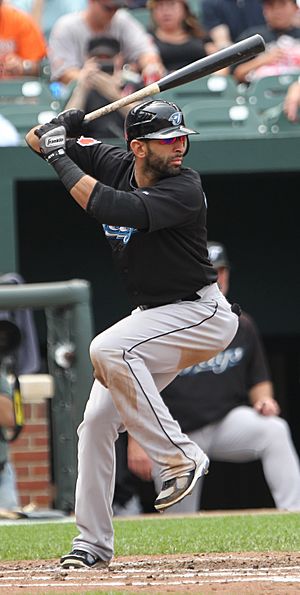
Led by new manager John Farrell, the Blue Jays' 2011 season was up and down. The team finished with an even record of 81 wins and 81 losses. José Bautista signed a big contract and followed up his record-setting 2010 season with a league-leading 43 home runs. Rookie J. P. Arencibia set a team record for catchers with 23 home runs. In August, young third baseman Brett Lawrie made his MLB debut and played very well.
Starting pitcher Ricky Romero led the team with 15 wins and became an All-Star. On July 31, the Blue Jays retired their first number, Roberto Alomar's #12.
- Team record 2011: 81 wins – 81 losses (50.0% winning), fourth in division
2012 Season
The 2012 season was full of injuries for the Blue Jays. They used 31 different pitchers, a team record. In June, three starting pitchers were injured in just four days. Some key hitters, like All-Star José Bautista, also missed a lot of time due to injuries. This caused the team to struggle, finishing with 73 wins and 89 losses. However, Casey Janssen became a reliable closer, and Edwin Encarnación became one of the league's best power hitters.
The team started the season with a very long game. They beat the Cleveland Indians 7–4 in 16 innings. This set a new record for the longest opening-day game in MLB history. On April 20, the Jays made a triple play against the Kansas City Royals. It was their first triple play since 1979.
- Team record 2012: 73 wins – 89 losses (45.1% winning), fourth in division
2013 Season
During the off-season, the Blue Jays made many trades and signed new players. They got Mark Buehrle, José Reyes, and Josh Johnson from the Miami Marlins. They also traded for R. A. Dickey and signed Melky Cabrera.
Despite high expectations, the 2013 team did not play as well as predicted. Most of the regular players battled injuries. José Reyes broke his ankle early in the season. One bright spot was the promotion of fan favorite Munenori Kawasaki. The Blue Jays also tied a team record with an 11-game winning streak in June. Edwin Encarnación had great numbers, with 36 home runs and 104 RBIs.
- Team record 2013: 74 wins – 88 losses (45.7% winning), last in division
2014 Season
Pitcher Roy Halladay signed a one-day contract with the Blue Jays before retiring due to injuries. The Jays had a nine-game winning streak in May. They also won 18 out of 21 games between May and June.
On August 10, the Blue Jays played the longest game in team history. They won 6–5 in 19 innings against the Detroit Tigers. The game lasted 6 hours and 37 minutes.
- Team record 2014: 83 wins–79 losses (51.2% winning), third in division
2015: Return to the Playoffs, AL East Champions
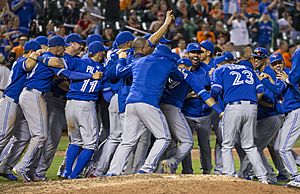
During the off-season, the Jays signed Toronto-born catcher Russell Martin. They also got Marco Estrada, Devon Travis, All-Star third baseman Josh Donaldson, and Michael Saunders in trades.
The Jays later traded José Reyes and young pitchers to the Colorado Rockies. In return, they got All-Star shortstop Troy Tulowitzki and reliever LaTroy Hawkins. Two days later, they got All-Star pitcher David Price from the Detroit Tigers.
The Jays had two 11-game winning streaks this season. On September 25, the Blue Jays made it to the playoffs! This ended the longest playoff drought in North American professional sports. They then won the AL East division title on September 30.
The Blue Jays faced the Texas Rangers in the ALDS. After losing their first two home games, they won the next three games in a row to win the series. This kind of comeback had not happened since 2012. In Game 5, Blue Jays' right fielder José Bautista hit a go-ahead, three-run home run. He then did a memorable "bat flip." Bautista later wrote an article about this moment.
The Blue Jays then played the Kansas City Royals in the ALCS. They lost the series 4–2. The Royals went on to win the World Series.
After the playoffs, Josh Donaldson was named AL MVP. He was the first Blue Jay to win this award since George Bell in 1987.
- Team record 2015: 93 wins–69 losses (57.4% winning)
2016–Present: The Ross Atkins Years
2016: Wild Card Winners
Paul Beeston's contract ended, and Mark Shapiro became the new president of the Blue Jays. Alex Anthopoulos resigned, and Ross Atkins took his place as General Manager.
During the off-season, David Price left the Blue Jays. The Blue Jays signed J. A. Happ.
On May 15, 2016, the Blue Jays and the Texas Rangers had a fight during a game. This happened when a Rangers pitcher threw a pitch at Jose Bautista. Bautista then made an illegal slide, and a Rangers player punched Bautista. Bautista was later suspended for one game.
The Blue Jays made several trades during the season to get new players. On October 2, 2016, the Blue Jays earned a Wild Card playoff spot. On October 4, 2016, the Blue Jays beat the Baltimore Orioles in the American League Wild Card Game. Edwin Encarnación hit a walk-off home run in the 11th inning to win the game. On October 9, 2016, the Blue Jays swept the Texas Rangers in the American League Division Series. This sent them to the American League Championship Series for the second year in a row. On October 19, 2016, the Blue Jays lost to the Cleveland Indians in Game 5 of the ALCS.
- Team record 2016: 89 wins–73 losses (54.9% winning)
2017 Season
On November 11, 2016, the Blue Jays signed designated hitter Kendrys Morales. On December 5, 2016, Steve Pearce signed with Toronto. On January 5, 2017, Edwin Encarnación signed with the Cleveland Indians. On January 18, 2017, Bautista signed a new contract with the Blue Jays.
By the end of April, the Jays had the worst record in all of MLB. On July 2, the Jays traded Jason Grilli. Steve Pearce hit two walk-off grand slams in just three days in late July.
The Blue Jays wore special red-and-white uniforms for some games in 2017. This was to celebrate Canada's 150th anniversary.
- Team record 2017: 76 wins–86 losses (46.9% winning), fourth in division
2018 Season
The Blue Jays did not re-sign José Bautista, and he became a free agent. The Blue Jays traded for Yangervis Solarte. They also signed Curtis Granderson and Seung-hwan Oh.
In July, the Blue Jays traded Pearce to the Boston Red Sox. They also traded three pitchers: J. A. Happ, Seung-hwan Oh, and Roberto Osuna. In August, the Blue Jays traded Josh Donaldson to the Cleveland Indians. They also traded Curtis Granderson.
On September 26, the Blue Jays announced that manager John Gibbons would not return for the 2019 season.
- Team record 2018: 73 wins–89 losses (45.1% winning), fourth in division
2019 Season
On October 25, 2018, the Blue Jays announced that Charlie Montoyo had been hired as their new manager.
Early in the season, the Blue Jays traded Kendrys Morales and Kevin Pillar. During the season, the Blue Jays called up three exciting young players for the first time: Vladimir Guerrero Jr., Cavan Biggio, and Bo Bichette. These players are all sons of former MLB players. Vladimir Guerrero Jr. and Cavan Biggio are sons of Hall of Famers.
Near the trade deadline, the Blue Jays traded Marcus Stroman and Aaron Sanchez.
- Team record 2019: 67 wins–95 losses (41.4% winning), fourth in division
2020 Season
Due to COVID-19 rules, the Blue Jays played most of their home games in Buffalo, New York. They played at Sahlen Field, which is the home ballpark of their minor league team. They finished the season with 32 wins and 28 losses. They made it to the playoffs as the eighth seed in the American League.
2021 Season
The Blue Jays played their first 21 home games of 2021 in Dunedin, Florida, also because of COVID-19 rules. They then played their next 23 home games at Sahlen Field. They finally returned to Rogers Centre on July 30. They finished the 2021 season with 91 wins and 71 losses. They were just one game behind the New York Yankees and Boston Red Sox for a playoff spot. Starting pitcher Robbie Ray became the fourth Blue Jays pitcher to win the Cy Young Award.
2022 Season
During the off-season, the Blue Jays lost All-Star Marcus Semien and Cy Young Award winner Robbie Ray. The Blue Jays strengthened their pitching by re-signing José Berríos and signing Kevin Gausman and Yusei Kikuchi. These moves helped the Blue Jays have their best season since 2015. They finished with 92 wins and 70 losses. They made the playoffs as the fourth seed in the American League. However, they lost their playoff series to the Seattle Mariners. In Game 2, the Mariners came back from being down seven runs to win the game and eliminate Toronto.
2023 Season
The 2023 season was the Blue Jays' 47th season in Major League Baseball. They started the season on March 30 and finished on October 1.
On September 1, the Blue Jays set a record. They became the first team in MLB history to beat every other opponent at least once in a single season. They made it to the postseason for the second year in a row. This was their third playoff appearance in four years.



